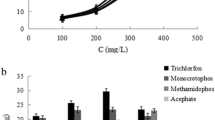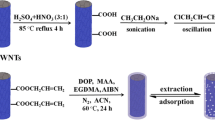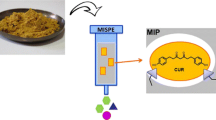Abstract
Spherical molecularly imprinted polymers (MIPs) were prepared by emulsion polymerization. The isothermal adsorption and selective adsorption indicated that the MIPs obtained exhibit excellent specific recognition for the template (atrazine) and its analogues. The MIPs were encapsulated in a polypropylene microporous membrane to fabricate MIP adsorption packages for the direct extraction of triazines in uncentrifuged and unfiltered tea extracts. The extraction conditions affecting the extraction efficiency, including the type and volume of extraction solvent, the number of MIP adsorption packages, the surface area of the MIP adsorption packages, the mass of MIPs in the MIP adsorption packages, the extraction time, the eluting solvent, and the eluting volume, were optimized. Under the optimal extraction and high-performance liquid chromatography–tandem mass spectrometry conditions, the method exhibited excellent linearity in the range from 0.5 to 250 ng g-1, with R2 ≥ 0.9992. The detection limit of the method was 0.09–0.18 ng g-1. The intraday and interday relative standard deviations ranged from 3.1% to 7.5% and from 3.1% to 7.9%, respectively. The method was successfully used to detect triazines in five tea samples. At a spiking concentration of 2 ng g-1, satisfactory recoveries ranging from (81 ± 3)% to (104 ± 7)% were obtained. The membrane-protected solid-phase extraction method based on molecularly imprinted material is expected to be widely used to enrich triazines in complex samples.

Schematic illustration of the MIPs combined with membrane-protected solid-phase extraction of triazines in tea sample



Similar content being viewed by others
References
Jiao W, Xiao Y, Qian X, Tong M, Hu Y, Hou R, et al. Optimized combination of dilution and refined QuEChERS to overcome matrix effects of six types of tea for determination eight neonicotinoid insecticides by ultra performance liquid chromatography-electrospray tandem mass spectrometry. Food Chem. 2016;210:26–34.
Du L, Ma L, Qiao Y, Lu Y, Xiao D. Determination of phthalate esters in teas and tea infusions by gas chromatography-mass spectrometry. Food Chem. 2016;197 Pt B:1200–6.
Zhou T, Ding J, Wang Q, Xu Y, Wang B, Zhao L, et al. Microwave-assisted rapid preparation of monodisperse superhydrophilic resin microspheres as adsorbent for triazines in fruit juices. Talanta. 2018;179:734–41.
Zhou T, Hou J, Yuan D, Li H, Zhang P, Li Y, et al. Determination of triazine herbicides from honey samples based on hydrophilic molecularly imprinted resins followed by high performance liquid chromatography-tandem mass spectrometry. RSC Adv. 2016;6:98663–73.
Wang S. A novel extraction method and its application to the analysis of pesticide residues in tea sample. Wuhan: Central China Normal University; 2013.
European Commission. Commission Regulation (EC) No 149/2008 of 29 January 2008 amending Regulation (EC) No 396/2005 of European Parliament and of the Council by establishing Annexes I, II and IV setting maximum residue levels for products covered by Annex I. Brussels: European Commission; 2008.
Wang A, Lu H, Xu S. Preparation of magnetic hollow molecularly imprinted polymers for detection of triazines in food samples. J Agric Food Chem. 2016;64(24):5110–6.
Wang X, Li X, Li Z, Zhang Y, Bai Y, Liu H. Online coupling of in-tube solid-phase microextraction with direct analysis in real time mass spectrometry for rapid determination of triazine herbicides in water using carbon-nanotubes-incorporated polymer monolith. Anal Chem. 2014;86(10):4739–47.
Zhao Q, Li H, Xu Y, Zhang F, Zhao J, Wang L, et al. Determination triazine pesticides in cereal samples based on single-hole hollow molecularly imprinted microspheres. J Chromatogr A. 2015;1376:26–34.
Gao B, Liu H, Cui K. Preparation and molecule-recognition characteristics of grafting type molecule-imprinted membrane and potentiometric sensor for atrazine. Sens Actuators B. 2018;254:1048–56.
Cladiere M, Delaporte G, Le Roux E, Camel V. Multi-class analysis for simultaneous determination of pesticides, mycotoxins, process-induced toxicants and packaging contaminants in tea. Food Chem. 2018;242:113–21.
Wu CC. Multiresidue method for the determination of pesticides in oolong tea using QuEChERS by gas chromatography-triple quadrupole tandem mass spectrometry. Food Chem. 2017;229:580–7.
Huo F, Tang H, Wu X, Chen D, Zhao T, Liu P, et al. Utilizing a novel sorbent in the solid phase extraction for simultaneous determination of 15 pesticide residues in green tea by GC/MS. J Chromatogr B. 2016;1023-1024:44–54.
Chuang YH, Zhang Y, Zhang W, Boyd SA, Li H. Comparison of accelerated solvent extraction and quick, easy, cheap, effective, rugged and safe method for extraction and determination of pharmaceuticals in vegetables. J Chromatogr A. 2015;1404:1–9.
Habibiyan A, Ezoddin M, Lamei N, Abdi K, Amini M, Ghazi-khansari M. Ultrasonic assisted switchable solvent based on liquid phase microextraction combined with micro sample injection flame atomic absorption spectrometry for determination of some heavy metals in water, urine and tea infusion samples. J Mol Liq. 2017;242:492–6.
Wu L, Hu M, Li Z, Song Y, Zhang H, Yu A, et al. Dynamic microwave-assisted extraction online coupled with single drop microextraction of organophosphorus pesticides in tea samples. J Chromatogr A. 2015;1407:42–51.
Sajid M, Basheer C, Mansha M. Membrane protected micro-solid-phase extraction of organochlorine pesticides in milk samples using zinc oxide incorporated carbon foam as sorbent. J Chromatogr A. 2016;1475:110–5.
Chen L, Wang X, Lu W, Wu X, Li J. Molecular imprinting: perspectives and applications. Chem Soc Rev. 2016;45(8):2137–211.
Ma Y, Pan G, Zhang Y, Guo X, Zhang H. Narrowly dispersed hydrophilic molecularly imprinted polymer nanoparticles for efficient molecular recognition in real aqueous samples including river water, milk, and bovine serum. Angew Chem Int Ed. 2013;52(5):1511–4.
Zhang Y, Liu R, Hu Y, Li G. Microwave heating in preparation of magnetic molecularly imprinted polymer beads for trace triazines analysis in complicated samples. Anal Chem. 2009;81:967–76.
Li X, Wang Y, Sun Q, Xu B, Yang Z, Wang X. Molecularly imprinted dispersive solid-phase extraction for the determination of triazine herbicides in grape seeds by high-performance liquid chromatography. J Chromatogr Sci. 2016;54(5):871–7.
Myriam D, Antonio M, Esther T. Hollow fibre membrane-protected molecularly imprinted microsolid-phase extraction (HFM-protected-MI-MSPE) of triazines from soil samples. Separations. 2018;5:8.
Barahona F, Diaz-Alvarez M, Turiel E, Martin-Esteban A. Molecularly imprinted polymer-coated hollow fiber membrane for the microextraction of triazines directly from environmental waters. J Chromatogr A. 2016;1442:12–8.
Andrade FN, Ide AH, Neng Nda R, Lancas FM, Nogueira JM. Determination of trace levels of triazines in corn matrices by bar adsorptive microextraction with a molecularly imprinted polymer. J Sep Sci. 2016;39(4):756–61.
Chen L, Li B. Magnetic molecularly imprinted polymer extraction of chloramphenicol from honey. Food Chem. 2013;141(1):23–8.
Zhou T, Ding J, Ni L, Yu J, Li H, Ding H, et al. Preparation of magnetic superhydrophilic molecularly imprinted resins for detection of triazines in aqueous samples. J Chromatogr A. 2017;1497:38–46.
Zhou T, Ding J, He Z, Li J, Liang Z, Li C, et al. Preparation of magnetic superhydrophilic molecularly imprinted composite resin based on multi-walled carbon nanotubes to detect triazines in environmental water. Chem Eng J. 2018;334:2293–302.
Acknowledgements
This work was supported by the Open Project of the State Key Laboratory of Urban Water Resource and Environment, Harbin Institute of Technology (no. QAK201809) and the Development Program of the Ministry of Science and Technology of Jilin Province, China (grant number 20150204070GX).
Author information
Authors and Affiliations
Corresponding authors
Ethics declarations
Conflict of interest
The authors declare that they have no competing interests.
Electronic supplementary material
ESM 1
(PDF 310 KB)
Rights and permissions
About this article
Cite this article
Zhou, T., Zhao, Q., Zhao, L. et al. Molecularly imprinted polymers combined with membrane-protected solid-phase extraction to detect triazines in tea samples. Anal Bioanal Chem 410, 5173–5181 (2018). https://doi.org/10.1007/s00216-018-1171-y
Received:
Revised:
Accepted:
Published:
Issue Date:
DOI: https://doi.org/10.1007/s00216-018-1171-y




